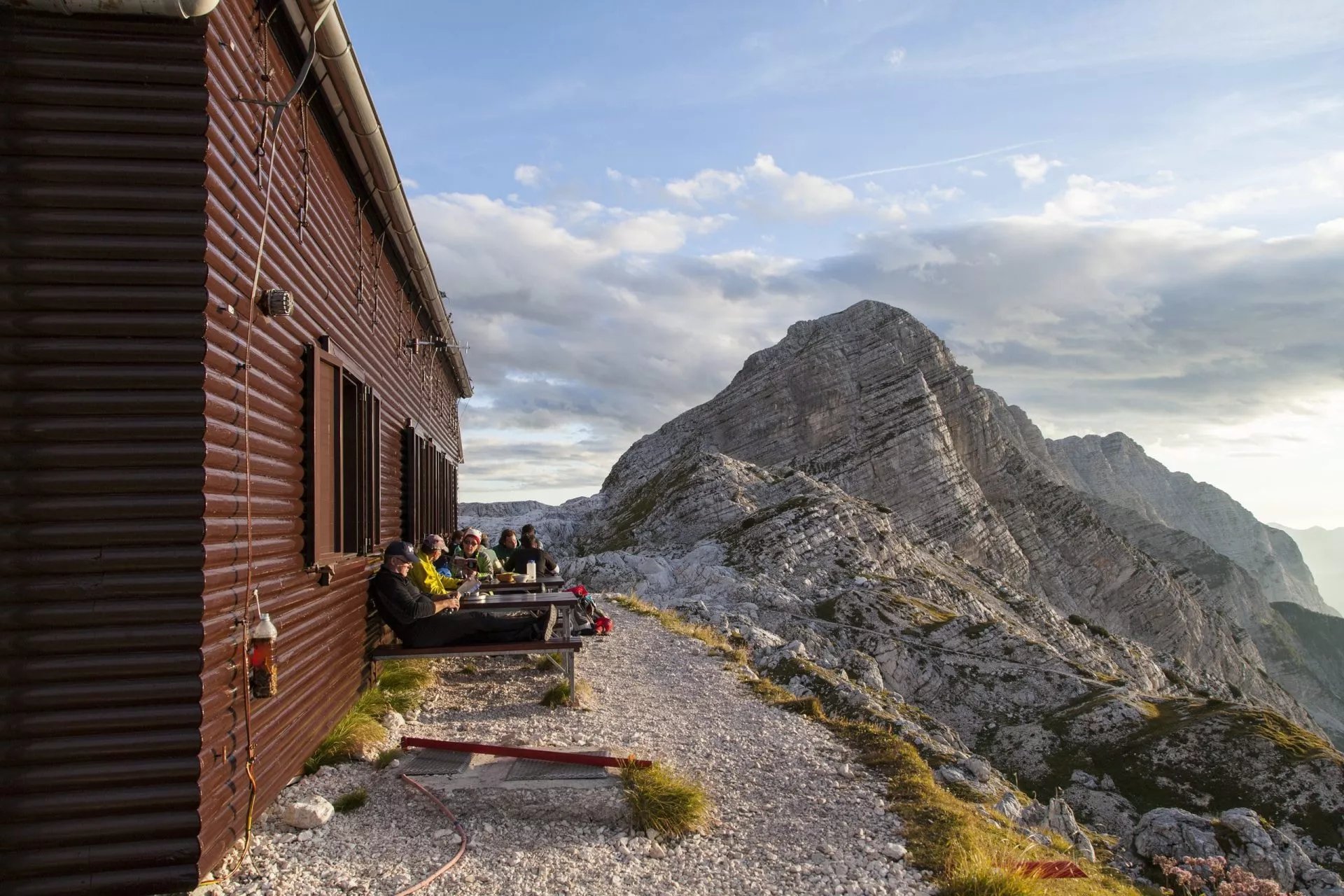About Mt. Triglav
Everything about Slovenia's symbol and the highest mountain Triglav in one place.

Mount Triglav
Standing the test of time proudly at 2,863.65 metres (9,395.2 ft), Triglav is the highest mountain in Slovenia and the king of the Julian Alps. But Triglav is much more than just a mountain; it’s the national symbol and pride of Slovenia. Depicted on the country’s flag, coat of arms and the fifty-cent coin, every true Slovene has to climb this legendary giant at least once in their lifetime. Or so the saying goes…

Where did Triglav get its name?
The literal translation of its name, deriving from the compound “Tri-glav”, is The Three-Headed, although all three of tis peaks can only be seen from the southeast. The origins of its name are rather more complex, and to a certain extent unclear. According to some sources, the tallest Slavic deity of the same name was supposed to have his throne on the top of the mountain. However, the common, albeit less romantic routes of Triglav’s name have been recorded as follows:
One of the oldest mentions was on a map from 1567, in which Triglav was called “Ocra mons”. Later, Johann Weikhard von Valvasor, Slovenia’s most renowned natural historian, named the mountain “Krma” in the second half of the 17th century. On the other hand, the German mountaineer Adolf Gstirner, insisted that the name Triglav first appeared in written sources as Terglau in 1452, but no surviving evidence of this exists.
The first to place the modern variant of the name on a map as Mons Terglou was Joannes Disma Floriantschitsch de Grienfeld in 1744. The name apparently stuck, and what an appropriate name it is!
Ascending Triglav is a well-preserved tradition
Triglav was first conquered in 1778 at the initiative of the industrialist and polymath Sigmund Zois. This maiden expedition consisted of four brave souls: a surgeon, Lovrenz Willomitzer, a chamois hunter, Štefan Rožič, and two miners Luka Korošec and Matevž Kos.
The main obstacle faced by these pioneers was the very sharp ridge between the small and big Triglav peaks. The men literally had to “saddle” narrow ridge and crawl their way to the top. Today, this ridge has been artificially widened and secured with a steel cable to allow safe ascent even for ordinary mortals.

On one occasion, 6,000 hikers ascended Triglav to witness the blessing of a mountain chapel.
The oldest person to reach the summit was a 90-year-old woman, and a guy called Franjo Potočnik, who has more than 1,000 climbs under his belt. He even stood on Triglav 366 times in one calendar year. It just goes to show you: Triglav is a very climbable mountain!

Aljaž Tower
Almost as famous as the mountain itself is the Aljaž Tower, a small iron storm shelter and triangulation point that greets visitors upon their arrival to the summit. It was commissioned by the priest, mountaineer and Slovenian patriot Jakob Aljaž in 1895.
Aljaž drew up his plans for a cylindrical tower on the floor of his room in the parish of Dovje with a piece of chalk. In an effort to restrain the increased interest of foreigners in the Slovenian mountains, he purchased the summit for the sum of one Austro-Hungarian gulden. This secured him the right to erect a building on the mountain’s peak. The tower was constructed from iron and zinc coated sheet steel by Anton Belec, who together with four others brought the parts of the tower to the summit and reassembled it in under five hours on 7 August 1895. The grand opening took place that same day, Aljaž officially donating the shelter to the Slovene Alpine Society.


The Triglav Glacier
Today the second largest of its kind in Slovenia, the Triglav Glacier used to be located below the summit on the karstified Triglav Plateaus, part of the north-eastern side of the mountain. It covered over 40 hectares by the end of the 19th century, only to shrink to a mere 15 hectares by 1946. Its increased dissolvement made it split in two by 1992, and by 2011 it covered an area of only 1–3 hectares, depending on the season.
In 2019, it was sadly no longer considered a glacier at all. An alarming fact that only intensifies in its tragedy if we consider that people could still ski on Triglav’s glacier 20 years ago.
Unbeknownst to many, a cave with a miniature glacial lake and dripstones lies 20 meters under the Kredarica mountain hut.

Triglav’s mighty North Face or The Wall
At 4 km wide and 1 km high, the Wall is among the largest and prominent mountain faces in Europe. It is a popular climbing destination and has played an important role in the rivalry between German and Slovenian alpinists. Over 140 routes lead up its formidable face, with over 30 first ascents done by the guru of modern mountaineering Franček Knez, but the most famous is probably the Čop Pillar climbed after a 5-day drama in 1945. Our mountain guides also take you up the Wall’s oldest and easiest route – the Slovene route. For something more difficult, don’t hesitate to ask!

All the routes that lead up Mt. Triglav
As should be expected for such a popular mountain and accessible mountain, visitors to Triglav can reach the summit along a multitude of various routes, and recharge their batteries at four mountain huts (Planika, Dolič, Kredarica and Staničev dom). Back in the day, an Italian military outpost also stood on the mountain’s western plateau.
You can approach Triglav in the northeast, from one of Triglav’s valleys, in the south, in Pokljuka or Bohinj, or in the northwest, in the Zadnjica valley. There are no shortcuts, so spending the night at one of the aforementioned huts comes highly recommended. Unless you opt for a one-day tour, that is.
TRIGLAV VALLEYS
Approaches from the northern, rockier side that lead past the Kredarica and Staničev dom huts.
From Vrata Valley via Prag (6-7 h): The most popular and easiest approach from the steep Vrata Valley, which also comes with some secured climbing parts with views of the North Face.
From Vrata along the Tominšek Trail (6-7 h): A slightly more demanding route, but perhaps more scenic. Because of several climbing sections, this route is more recommended for ascents than descents.

From the Kot Valley (6-7 h): The least visited Triglav valley. A short, secured ascent above the valley’s end is followed by a relatively long climb to the Staničev dom hut.
SOUTH SIDE
The routes along the southern side of the Triglav are lined with grassy slopes and visitors can spend the night at the Vodnikov dom and Planika huts, as well as the Tržaška koča na Doliču, Zasavska koča na Prehodavci and Koča pri Triglavskih jezerih mountain huts.
From the Krma Valley (5-7 h): The path through the easternmost part of the Triglav is the quickest and the easiest approach, as it does not include any demanding sections.
From Pokljuka (6-7 h): The route from Pokljuka (either from Rudno polje or Uskovnica) offers the highest starting point and thus the smallest elevation differences. The tour is long yet varied and relatively undemanding until the final section before the summit.
From Bohinj via Voje (7-8 h): A strenuous choice with a significant elevation difference that joins the route from Pokljuka.
From Bohinj along the Triglav Lakes Valley (10-11 am): This spellbinding route, which leads past the stunning Triglav Lakes, is not the most nature-packed approach. Due to its incredible scenic views of the mountains, many hikers associate it with the path to Triglav. It is especially popular as a tour extension after conquering Triglav. Because of its length, it is most enjoyed as a multiple day tour.

TRENTA VALLEY
Approaches from Trenta or Zadnjica are long and typical high mountain routes. Tržaška koča hut is the place to stay.
From Zadnjica via Luknja and Plemenice (7-8 h): A relatively relaxing route that leads to the Luknja Saddle before joining the most demanding approach across Plemenice.
From Zadnjica via Dolič (8-9 h): A route full of military history with a considerable difference in altitude, but a relatively undemanding slope.
From Zadnjica via Komar and Dolič (7-8 h): Steeper, partially secured “shortcut” to Dolič.
PEAK ASCENT
Right before the final leg of the Triglav ascent, most of most routes merge into one. All options up to the highest point are demanding yet secured, so safety equipment is paramount.
From Kredarica: Not the easiest, but a well-secure classic route via Mali (Small) Triglav (2738 m) and a dizzyingly narrow peak ridge.
From Planika via Mali Triglav: It was the route taken by the first four men to reach the summit in the 18th century and remains the easiest option. It avoids the steep wall above Kredarica, and follows an extremely picturesque ridge.
From Planika via Triglavska škrbina: After a renovation, this route is well secured and can be a perfect alternative to a more crowded ridge.
From the Western Triglav Plateau: This route to the summit runs from Dolič or Luknja. A short, secure section to Triglavska škrbina is followed by somewhat easier climbing to the top.

What can I see from Triglav?
It should come as no surprise that the views from Triglav are unbelievably gorgeous, to say the least. On a clear day, you can see the Adriatic Sea, the Dolomites, the Karawanks, the Kamnik-Savinja Alps, and across most of Slovenia to the Pohorje Hills.
Join us on our Triglav tours and enjoy the view!

Expert Local Guides
Our professional guides know the local terrain and are trained to make this once-in-a-lifetime opportunity both safe and enjoyable.

Top Notch Equipment
We provide equipment rentals of helmets, harnesses, and more, by world-class quality brands.

Hassle-Free
We handle route planning, accommodations, transfers, and anything else you prefer not to deal with, so you can enjoy a carefree hike.

Trusted by Many
We are a financially protected company operating since 2014, and with thousands of satisfied customers in the past, we still put you first.

